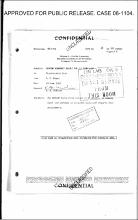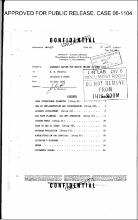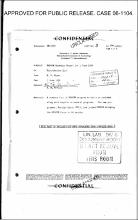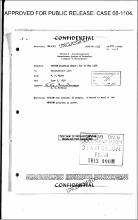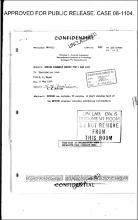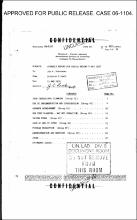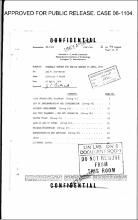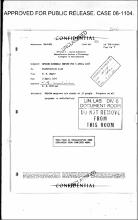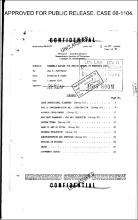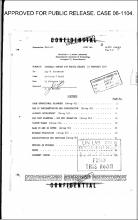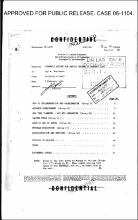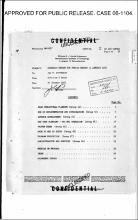Project Whirlwind Reports
Browse by
The development of Whirlwind I, one of the first large scale high speed computers, began during World War II as part of a research project to develop a universal flight trainer that would simulate flight (the Aircraft Stability and Control Analyzer project). It was initiated by the Office of Naval Research and began at the Massachusetts Institute of Technology Servomechanisms Laboratory in 1944. Eventually the focus of the grant, a flight simulator (using an analog computer), changed to developing a high speed digital computer. While building the computer, researcher Jay W. Forrester invented random--access, coincident-current magnetic storage which became the standard memory device for digital computers. For this he was granted a patent in 1956. Prior to Forrester's discovery electrostatic storage tubes were used. The introduction and change to magnetic core memory provided high levels of speed and of reliability.
A public announcement was made in late 1951 that the computer known as "Whirlwind I" was operational and available for scientific and military research. In 1951 Project Whirlwind was detached from the Servomechanisms Lab to become the Massachusetts Institute of Technology Digital Computer Laboratory. Unclassified research projects using the Whirlwind I computer were managed by the Digital Computer Lab staff on the MIT campus, where Whirlwind I occupied the Barta Building (N42), which had been acquired in 1947 to provide sufficient space for the computer as it was designed and constructed. In 1952 staff working on classified projects left to be part of the newly organized Lincoln Laboratory off campus, to form Division 6, Digital Computer Division. Although their projects were classified, the Whirlwind computer itself was not, and remained in the Barta Building. Jay Forrester served as director of both the Digital Computer Laboratory and Division 6, Lincoln Laboratory until 1956, when he became a member of the MIT faculty pursuing interests in system dynamics in management. Robert Everett served as associate director of both labs until he succeeded Forrester as director.
The U.S. Air Force provided substantial financial support for Whirlwind applications and it was a key component in the design of the Air Force's SAGE (Semi-Automatic Ground Environment) air defense system in the 1950s. Research projects at Lincoln Laboratory, resulted in the further development of two additional computers, the MTC (memory test computer) and TX-O (transistor computer), by Group 63 of Lincoln Lab, Division 6.
In July 1958 The MITRE Corporation was incorporated as a non-profit organization to continue classified research and development projects that had transitioned to an operational stage and needed to be phased out of Lincoln Laboratory. Robert Everett joined MITRE at that time as technical director, later serving as president of MITRE from 1969 to 1986.
As described in MIT's Tech Talk, "the Beast" of the Barta Building, the Whirlwind I computer, was shut down on May 29, 1959. It was leased by the Navy to the Wolf Research and Development Corporation of Massachusetts, and was disassembled, and moved out of the Barta building in the spring of 1960. Computer artifacts from Whirlwind I and related Whirlwind projects are held by the Massachusetts Institute of Technology Museum and the Computer History Museum, Mountain View, California.
Further information can be found in the following archival collections and published books:
- Biographical sketch, Jay W. Forrester. Sloan School of Management System Dynamics paper D3110
- Project Whirlwind Collection, MC 665 (MIT Archives)
- MIT Servomechanisms Laboratory records, AC 151 (MIT Archives)
- MIT Digital Computer Laboratory records, AC 362 (MIT Archives)
- Jay Forrester papers, MC 439 (MIT Archives)
- Karl L. Wildes papers, MC 322 (MIT Archives)
- MIT Magnetic Core Memory Patent Litigation records, AC 337 (MIT Archives)
- Whirlwind I Collection (Smithsonian Museum of Science and Technology Archives)
- Project Whirlwind: the history of a pioneer computer by Kent Redmond and Thomas Smith. Bedford, MA, Digital Press, 1980.
- From Whirlwind to MITRE, the R & D Story of the SAGE Air Defense Computer, by Kent Redmond and Thomas Smith. MIT Press, 2000.
- A History of Computing in the Twentieth Century, chapter on Whirlwind by Robert R. Everett. Academic Press, 1980.
Recent Submissions
-
Biweekly Report for Period Ending 29 June 1956
(Lincoln Laboratory - Division 6, 1956-07-05)Bi-weekly progress report of Division 6 research teams. -
EPSCOM Biweekly Report for 15 June 1956
(Lincoln Laboratory - Division 6, 1956-06-20)The EPSCOM force still stands at 40 people. A summary chart and schedule is included along with reports from programmers.. -
Biweekly Report for Period Ending 15 June 1956
(Lincoln Laboratory - Division 6, 1956-06-20)Bi-weekly progress report of Division 6 research teams. -
Biweekly Report for Period Ending 1 June 1956
(Lincoln Laboratory - Division 6, 1956-06-11)Bi-weekly progress report of Division 6 research teams. -
EPSCOM Biweekly Report for 1 June 1956
(Lincoln Laboratory - Division 6, 1956-06-07)A summary of EPSCOM program activity is included along with reports on several programs. One new programmer, Marilyn Lynch (BTL), has joined EPSCOM bringing the EPSCOM force to 40 people. -
Biweekly Report for Period Ending 18 May 1956
(Lincoln Laboratory - Division 6, 1956-05-24)Bi-weekly progress report of Division 6 research teams. -
EPSCOM Biweekly Report for 18 May 1956
(Lincoln Laboratory - Division 6, 1956-06-05)EPSCOM now includes 39 people. A report on most of the EPSCOM programs is given. -
EPSCOM Biweekly Report for 4 May 1956
(Lincoln Laboratory - Division 6, 1956-05-10)EPSCOM now includes 38 people. A chart showing most of the EPSCOM programs includes scheduling information. -
Biweekly Report for Period Ending 4 May 1956
(Lincoln Laboratory - Division 6, 1956-05-11)Bi-weekly progress report of Division 6 research teams. -
EPSCOM Biweekly Report for 20 April 1956
(Lincoln Laboratory - Division 6, 1956-04-27)EPSCOM, now Group 66, with 37 people including a new secretary at Murphy Hospital, is being reorganized into 3 subsections. -
Biweekly Report for Period Ending 20 April 1956
(Lincoln Laboratory - Division 6, 1956-04-26)Bi-weekly progress report of Division 6 research teams. -
EPSCOM Biweekly Report for 6 April 1956
(Lincoln Laboratory - Division 6, 1956-04-09)EPSCOM manpower now stands at 35 people. Progress on all programs is satisfactory. -
Biweekly Report for Period Ending 6 April 1956
(Lincoln Laboratory - Division 6, 1956-04-13)Bi-weekly progress report of Division 6 research teams. -
Biweekly Report for Period Ending 23 March 1956
(Lincoln Laboratory - Division 6, 1956-03-29)Bi-weekly progress report of Division 6 research teams. -
Biweekly Report for Period Ending 9 March 1956
(Lincoln Laboratory - Division 6, 1956-03-16)Bi-weekly progress report of Division 6 research teams. -
Biweekly Report for Period Ending 24 February 1956
(Lincoln Laboratory - Division 6, 1956-03-01)Bi-weekly progress report of Division 6 research teams. -
Biweekly Report for Period Ending 10 February 1956
(Lincoln Laboratory - Division 6, 1956-02-23)Bi-weekly progress report of Division 6 research teams. -
Biweekly Report for Period Ending 27 January 1956
(Lincoln Laboratory - Division 6, 1956-02-02)Bi-weekly progress report of Division 6 research teams. -
Biweekly Report for Period Ending 13 January 1956
(Lincoln Laboratory - Division 6, 1956-01-20)Bi-weekly progress report of Division 6 research teams. -
Biweekly Report for Period Ending 30 December 1955
(Lincoln Laboratory - Division 6, 1956-01-06)Bi-weekly progress report of Division 6 research teams.


